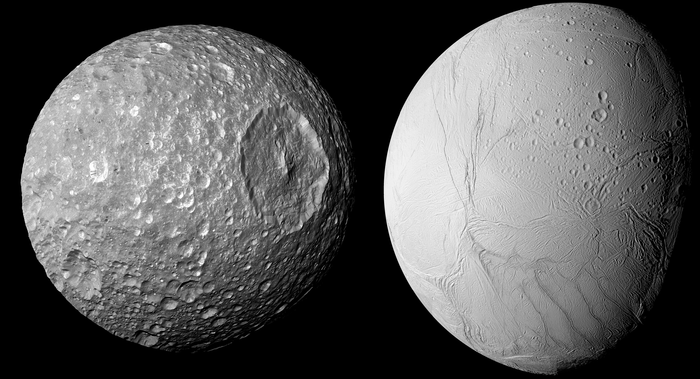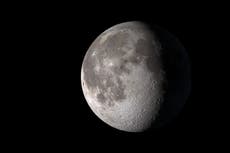Saturn’s ‘Death Star’ moon could have an internal ocean full of water, study finds
Mimas may have a ‘stealth’ ocean of liquid water deep under its icy surface

Mimas – the tiny, innermost moon of Saturn that bears resemblance to the Death Star from Star Wars – may have an internal sub-surface ocean, a new study has suggested.
The new research, published in the journal Icarus on Wednesday, assessed data from Nasa’s now-defunct Cassini spacecraft, and found that Mimas may have a “stealth” ocean of liquid water deep under its icy surface.
In its waning days, Cassini identified some oscillations in the moon’s rotation, which researchers from the Southwest Research Institute (SwRI) in the US say indicates evidence of a geologically active body capable of supporting an internal ocean.
Over the last two decades, thanks to measurements by several spacecraft sent to study planets and their moons, scientists have found that worlds with oceans beneath layers of rock and ice are common in our solar system.
These include the icy moons of giant planets like Jupiter and Saturn, such as Europa, Titan, and Enceladus.
While planets like the Earth with surface oceans must reside within a narrow range of distances from their stars to maintain the temperatures needed for supporting liquid oceans, the discovery of these interior water ocean worlds has greatly expanded the number of potentially habitable regions in the galaxy.
Researchers said that interior water ocean worlds such as Enceladus and Europa usually tend to be fractured and show other signs of geologic activity, but the surface of Mimas is heavily cratered, leading them to believe it was just a frozen block of ice.
“If Mimas has an ocean, it represents a new class of small, ‘stealth’ ocean worlds with surfaces that do not betray the ocean’s existence,” SwRI’s Alyssa Rhoden, a specialist in the geophysics of icy satellites, said in a statement.
“Turns out, Mimas’ surface was tricking us, and our new understanding has greatly expanded the definition of a potentially habitable world in our solar system and beyond,” Dr Rhoden added.
In such cold worlds with hidden sub-surface oceans, tidal processes dissipate orbital and rotational energy as heat.
Scientists calculated the tidal heating that would be generated within an ocean-bearing Mimas, and based on that, determined the ice shell thicknesses that would result.
The oscillation in Mimas spotted by Cassini suggests that the moon’s interior is warm enough for a liquid ocean, but not so warm it compromises the moon’s thick shell of ice about 24 km to 31 km thick.
The ability of Mimas to host the ice shell over an ocean depends on the flow properties of the ice, the surface temperature, and its heat flow, researchers said.
“We find that, using the most reasonable assumptions, Mimas would have the suggested ocean and ice shell thicknesses today,” they added.
An earlier study, published in 2014 based on data from Cassini, also suggested the wobbles of Mimas indicated the moon had either a “rugby ball-shaped rocky core” or a “sloshing sub-surface ocean.”
“Evaluating Mimas’ status as an ocean moon would benchmark models of its formation and evolution. This would help us better understand Saturn’s rings and mid-sized moons as well as the prevalence of potentially habitable ocean moons, particularly at Uranus,” Dr Rhoden added.
Join our commenting forum
Join thought-provoking conversations, follow other Independent readers and see their replies
Comments


Bookmark popover
Removed from bookmarks